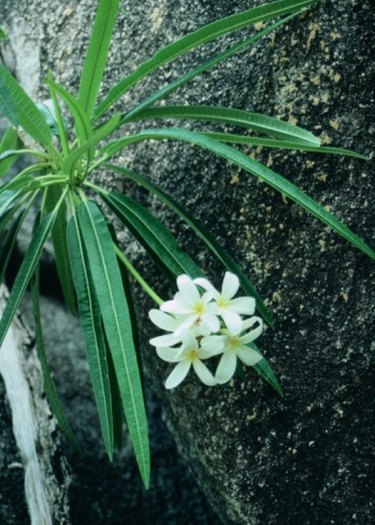
Africa has diverse plant life due to the continent's variety of landscapes. Desert, grassland, forest, thickets and savannas support different types of plants. In addition, the continent has broad differences in temperature, rainfall, topography and types of soil that create a variety of ecosystems for African plants. Africa is also home to a number of poisonous plants that can endanger both humans and livestock.
Bloutulp Flowers From Africa
Video of the Day
The bloutulp, or Moraea polystachya, is a perennial plant that bears white or violet trumpet-shaped flowers. The bloutulp can be found in the central region of southern Africa, often in grazing lands where farmers and ranchers become concerned about their livestock eating this poisonous plant. Bloutulp grows 2 1/2 feet tall with a multibranched flower stem at the top.
Video of the Day
Each flower blooms for only one day, but the plants produce a succession of blooms. They bloom March to May in the northern areas but June to October in the south. The poison has been identified as a heart toxin.
Beautiful But Dangerous African Oleander
Nerium oleander is a native of northern Africa that prefers a dry, warm climate. It is an evergreen shrub that can grow to 20 feet tall, in a rounded shrub. Its leaves are lance-shaped and grow 4 to 10 inches long with a bright green color. Oleander bears profuse flowers in white, salmon, pink or yellow.
This plant has adapted to many regions of the world and is often used as an ornamental plant in home landscapes abroad as well as in the United States. The oleander is poisonous when ingested, however, and should not be used in areas where children and pets can consume foliage. You should also avoid burning all parts of this African flowering plant as yard waste. The fumes when burning oleander are as toxic when breathed as the plant parts are when ingested.
African Wild Cucumber
Also known as the balsam apple, botanical name Momordica charantia, the wild cucumber grows as a vine with dark green, deep-lobed leaves. It is a native of tropical Africa. The plant produces yellow blossoms that eventually become a bright red-skinned fruit with red pulp and seeds like those of the cucumber. Both the skin and the seeds are toxic. The vines can quickly cover large areas and should be controlled with a herbicide with the active ingredient glyphosate. Careful removal of the fruit from the dead vines is necessary to prevent further invasion of the vine.
Stinkblaar Plants in Africa
Datura stramonium, or stinkblaar, is an annual African Plant that can be found throughout Africa. It has been held responsible for the poisonings of children. Also called thorn apple, it is recognized by its purple stems, toothed leaves and spiked fruits. It can be found along roads, in fields and even in cultivated areas. The seeds are rich in tropane alkaloids, which are autonomic nervous system toxins. The strength of the toxins can vary due to environmental conditions. Some people attempt to use the toxins of the plant as a narcotic agent, but their use can end in death.